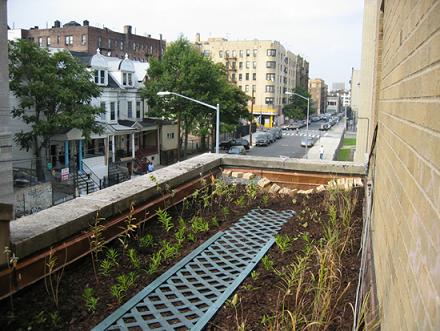
Newly Established Green Roofs at St. Simon Stock, Bronx, NY
The Gaia Institute is continuing progress in designing, constructing, modeling and monitoring green roofs throughout New York City. The ecological and economic benefits of growing plants on rooftops have been investigated in various cities in the United States as well as in Europe and Asia. In an increasing number of cities, including New York, green roofs are seen as one of the few potentially cost-effective solutions capable of addressing severe environmental hazards – the urban heat island effect and combined sewer discharge, both of which can affect environmental quality and human health in urban areas.
The Gaia Institute has developed and patented GaiaSoil, an ultra-lightweight soil composed of recycled expanded polystyrene as the main component. The polystyrene is modified in order to hold water, minerals, and nutrients, making these available for plant growth. GaiaSoil's ultra-lightweight nature, only about half the density of water, makes it suitable for most rooftop applications.
The Gaia Institute's green roofs are engineered to be an ultra-lightweight roofing system that promotes plant growth while preserving the integrity of the roof membrane integrity by eliminating damage from the Sun's ultraviolet radiation. Gaia’s pilot green roof projects are presently generating data to help quantify the benefits associated with green roof technology. Modeling efforts are underway in collaboration with Earth Pledge and Hydroqual Inc.
The students at the St. Simon Stock elementary school are participating in the establishment and care of the plants associated with their green roof. The school faculty is developing a curriculum that utilizes the plants and soil, as well as the animal life they attract and support, as a tool for interdisciplinary education. Students will take an ongoing role in planting and harvesting a variety of fruits and vegetables, as well as in data collection and analysis and writing papers and reports on their green classroom.
The primary benefits of green roof construction include:
-
•Reducing the amount of runoff that reaches the existing combined sewer during rainfall events, minimizing the volume of water and sewage in combined sewer overflow events.
-
•Mitigating the 'urban heat island effect' by shading the roof and evaporating stormwater, thus cooling the roof and the top of the building and releasing cool air into the city.
-
•Increasing the insulation capacity of the roof, resulting in energy cost savings for building owners.
-
•Protecting the roof membrane from damage and leakage due to UV radiation, freeze/thaw cycles, and trauma.
-
•Creating habitat for wildlife such as birds and butterflies which use the coastal flyway that New York City occupies in their migrations north and south.
-
•Enhancing environmental aesthetics, increasing biodiversity, and providing usable space for building occupants.
-
•Sequestering atmospheric carbon, reducing the effect of increased greenhouse gas emissions
One 300 square foot green roof has been established at the St. Simon Stock Convent on 182nd Street and Ryer Avenue in the Bronx. Soil tensiometers, which monitor soil water holding capacity, have shown the ultra-lightweight GaiaSoil to be effective in maintaining adequate moisture levels even for rain events as much as two weeks apart, supporting plant growth, and acting as buffers which can keep a large fraction of incoming rainfall out of the storm sewers.
A 3,500 square foot green roof was constructed in June of 2005 above the St. Simon Stock Elementary School, and precision monitoring equipment including a weather station, thermo-couples, and soil moisture probes have been installed. This equipment is serving educational goals, as well as helping to monitor how much water is held and used by the soil and plants under varying rainfall and climatic conditions. The Gaia Institute has also developed a mathematical model to predict the amount of stormwater capture that green roofs can provide in urban stormsewersheds.
(Photo: Green Roof at St. Simon Stock School, Bronx, NY, 2005)


(Photo: Green Roof at St. Simon Stock Convent, Bronx, NY, 2005)
Green Roofs at St. Simon Stock
The Gaia Institute - 440 City Island Avenue - Bronx, NY 10464
